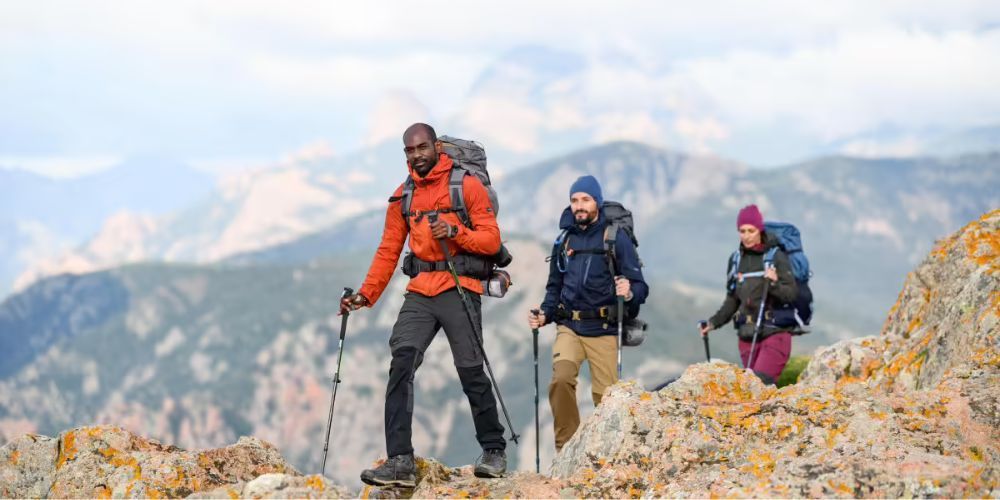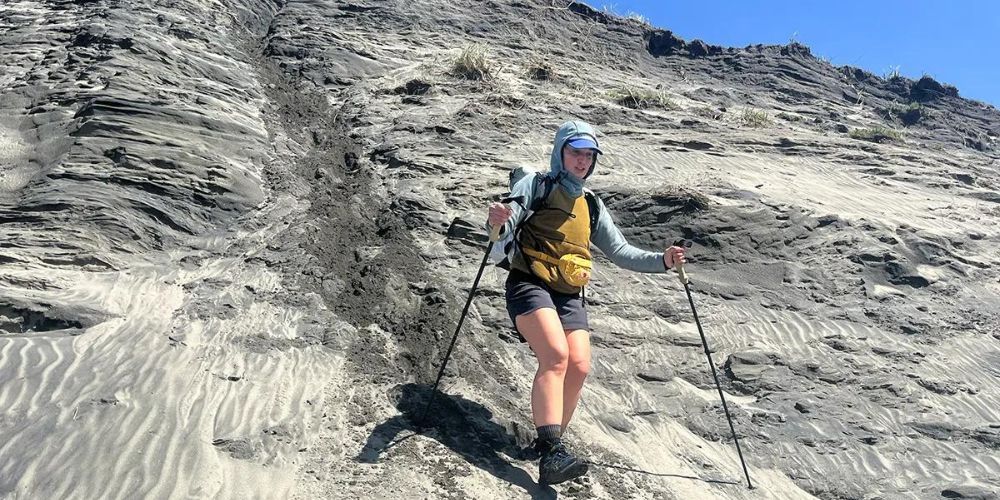Mastering Hiking Poles: A Step-by-Step Guide to Using Them Effectively
July 14, 2024
Using hiking poles properly can make all the difference between an enjoyable hike and one that leaves you drained and sore. They are not just there for show; the correct technique prevents fatigue and injuries, especially on long trails. Imagine hearing the rhythmic tap of your poles guiding you smoothly over challenging terrain—it’s about mastering balance and efficiency.
To help you achieve this level of proficiency, we've delved into expert advice and practical tips. It's essential to start with choosing the right poles tailored to your needs. The details matter starkly—from material choices like aluminum versus carbon fiber to grip preferences suited to your comfort. Selecting the right hiking poles sets the foundation for effective use on any adventure.
To use hiking poles effectively, start by adjusting them to the correct height, typically with your elbows at a 90° angle. When trekking uphill, plant the poles securely and adjust their length for leverage. Distribute your weight evenly between your legs and poles to reduce impact on joints and improve stability. Always test out different techniques, grips, and strides to find what works best for you.

Selecting the Right Hiking Poles
When it comes to choosing the right hiking poles, several factors can significantly impact your hiking experience. At first glance, trekking poles and hiking staffs may appear quite similar, but they have distinct differences that can make or break your outdoor adventure.
Types of Poles
Understanding the difference between trekking poles and hiking staffs is fundamental. Trekking poles, sold as a pair, are designed to provide better stability and reduce force on the knees. They are ideal for hikers who traverse varied terrain types and elevations, offering support and balance on inclines and declines. On the other hand, hiking staffs are used singly and are best suited for relatively flat terrains when carrying little or no load. They provide extra stability on even ground and can also be used as a tool for gauging depth or probing tricky areas.
Taking the time to assess your intended hiking environment, whether it be hilly or flat, will help guide you in making an informed decision about which type of pole is best suited for your needs.
Material Considerations
The material of your hiking poles is another critical aspect to consider. Aluminum poles are known for their durability and budget-friendly nature. They are well-suited for those who are rough on their gear or hike in challenging conditions. Conversely, carbon fiber poles offer a lighter alternative but come with a higher price tag. The weight savings provided by carbon fiber poles can be particularly advantageous for long hikes where every ounce counts.
Consider the type of terrain you will primarily encounter during hikes when choosing between aluminum and carbon fiber poles. For example, if you’re planning more rugged treks with rocky or uneven surfaces, the sturdiness of aluminum might be preferable. On the other hand, if you’re venturing into long-distance hikes where weight becomes a crucial factor, carbon fiber could be more suitable.
Grip Preferences
The grip material of your hiking poles plays a significant role in your comfort and overall hiking experience. Cork grips are renowned for their ability to wick away moisture while still providing a comfortable grip for long periods. In contrast, foam grips prioritize comfort and reduced shock absorption, making them a great choice for those seeking extra cushioning. Finally, rubber grips are valued for their durability and ability to hold up well over time.
For instance, if you tend to perspire heavily during hikes, cork grips can help maintain a secure hold on the poles without becoming slippery due to sweat buildup.
Adjustable Features
Look for hiking poles with adjustable length features and shock absorption capabilities to cater to various terrains and personal preferences. The locking mechanisms of these adjustable features also play a role in ease of use and stability; twist locks and flick locks each offer distinct benefits that should be considered based on your specific needs and user experience preference.
Some hikers might prefer twist locks due to their simplicity and lower chance of malfunctioning, while others might lean towards flick locks for their reliability in maintaining pole length once set.
Selecting the right hiking poles involves careful consideration of various factors tailored to your individual needs and preferences. It’s worth putting in the effort at this stage to ensure that you have a reliable companion on all your future hiking expeditions.
Having comprehensively understood the nuances involved in selecting the most suitable hiking poles, it’s time to move onto mastering the proper length settings and setup techniques. This next phase will set the stage for an optimized hiking experience.
Adjusting Pole Length and Setup
One of the key elements of properly using your hiking poles is setting them to the correct length. Adjusting the length not only provides stability but also reduces strain on your body. When gripping the poles, you should aim for your elbows forming a 90-degree angle, ensuring that they are just at the right height for maintaining balance and providing support. This small adjustment can make a big difference in enhancing your hiking experience.
Proper alignment is crucial, like tuning an instrument before a performance. Just as a musician ensures their instrument is in perfect harmony, hikers should ensure their poles are set to the correct length for optimal performance. It's a simple adjustment that can greatly impact your comfort and endurance during long treks.
Terrain-Specific Adjustments
In addition to adjusting the length for your height, it's essential to know when and how to make terrain-specific adjustments. For uphill climbs, shortening the poles will give you better leverage and help plant them more securely as you ascend. On the other hand, when descending, lengthening the poles provides increased stability and support, especially on steep declines. These simple adjustments cater to the varying demands of different terrains and inclines, allowing you to move with greater ease.
Imagine adjusting your poles according to the terrain as similar to changing gears while driving - it's about adapting to the conditions of the "road" ahead of you.
Ensuring Locks Are Secure
Before embarking on your hike, it's important to verify that all locking mechanisms are tightly secured. A sudden collapse due to poorly secured locks could lead to injury or hinder your progress on the trail. Checking these mechanisms beforehand instills confidence in their reliability and prevents potential accidents along the way.
Remember: Always double-check that your locks are secure before starting your hike to avoid any unexpected mishaps.
Properly adjusting your hiking poles enhances stability, reduces strain, and allows for customized support based on the terrain—a small but crucial detail that ultimately makes a significant difference in your hiking experience.

Proper Grip and Wrist Position
When it comes to using hiking poles effectively, paying attention to your grip and wrist position is crucial. Picture a situation where you rely on your poles for support on a steep downhill slope or unstable ground; a secure, comfortable grip could make the difference between feeling confident and in control or feeling unsteady and unsafe. Let's break down the key elements of a proper grip and how to set up your wrist position for optimal performance.
First things first, when fitting your hands into the straps, it's essential to ensure that your hand goes in from below and through the strap. Once your hand is inserted, grip the pole comfortably, allowing your wrist to bear most of the weight without causing strain. This not only helps distribute the weight more evenly but also reduces hand fatigue during longer hikes.
Advantages of Correct Hand Placement:
- Reduced fatigue: By distributing the weight to the wrist, you'll experience less fatigue in your hands over extended use.
- Improved control: Placing your hand through the strap properly allows for better control and maneuverability.
When adjusted correctly, wrist straps provide added stability during challenging terrain and ensure comfortable support without cutting into your skin or causing discomfort during long treks. Some hikers debate whether to use wrist straps at all, noting that they can feel restrictive. However, when adjusted properly, they actually allow for better distribution and can minimize strain on your hands and wrists over time. Comfortability will vary from person to person, but it's worth experimenting with different adjustments while out on a hike.
Lastly, when wrapping your fingers around the grip, adopt a light grip rather than holding tightly. This prevents blisters from forming due to friction and avoids unnecessary strain on your fingers and palms. Lightly gripping the poles also promotes a more fluid motion while walking.
So remember, when using hiking poles, a proper grip combined with optimal wrist position isn't just about comfort—it's about reducing fatigue, improving control, and ensuring stability as you tackle the trail ahead.
In this meticulous pursuit of mastering hiking pole techniques, let's now shift our focus to delving into additional fundamental methods that can significantly enhance your hiking experience.

Mastering Basic Techniques
Whether you're navigating steep inclines or challenging terrain, trekking poles become an extension of your body, providing stability and helping maintain a steady rhythm. To master the basic techniques, it's important to pay attention to your walking rhythm, planting technique, and arm movement.
Walking Rhythm
Synchronization is key. As your right foot steps forward, your left pole should move forward in unison. This coordinated action helps distribute your weight evenly and maintain balance across different terrains. It's akin to a dance - when one part of your body moves, the other part follows in perfect harmony.
Benefits: Syncing your leg and pole movements prevents placing too much stress on one side of your body, reducing fatigue and preventing strain on specific muscles.
Planting Technique
The next fundamental technique is how you plant the poles with each step. When placing the tip of the pole on the ground ahead of your step, ensure it lands firmly before shifting your weight onto it. This action stabilizes your body as you move forward, preventing sudden slips or shifts on uneven terrain.
Importance: Proper planting ensures that your poles provide the support and stability needed while traversing varied landscapes. It also allows testing the ground ahead for stability and safety before shifting body weight.
Arm Movement
It's imperative to keep arm movements natural and relaxed while using hiking poles. As you walk, allow your arms to move just slightly ahead of your stride, maintaining a fluid walking motion. Engaging arms in this manner provides crucial upper-body involvement, promoting a balanced and harmonious walking experience.
Why It Matters: The gentle swinging movement of the arms encourages a rhythmic pace, reducing strain on the lower body and maximizing energy efficiency during long treks or challenging ascents.
By mastering these basic techniques, you're setting yourself up for a smoother and more enjoyable hiking experience. But there's still more to learn in order to truly harness the power of hiking poles—let's continue honing our skills!
Using Poles on Various Terrains
Different terrains call for different uses of your hiking poles - just like how a car's speed changes depending on if you're driving through city streets or country roads. Let’s explore three common types of terrains: flat, rocky, and muddy/wet, and how to effectively utilize your poles in each one.
Flat Terrain
On flat ground, the goal is to maintain balance. Adjust your trekking poles to a moderate length, allowing your arms to swing easily as you walk. This setting provides gentle support without exerting excessive force—a perfect balance.
It's like having a companion by your side as you stroll down a level path - someone who is always there to lend a hand when needed but doesn't interfere unnecessarily.
Rocky Terrain
When negotiating rocky surfaces, your poles become your guides. Use them to test the stability of rocks before shifting your weight onto them. Shorten the poles slightly to enhance control and maintain balance on uncertain or unstable ground.
Shortening your poles in this situation reduces the risk of overreaching, especially with heavier hikers and backpackers. Similar to how a tightrope walker uses an extended pole for balance, shortening your hiking poles creates greater control and stability.
Muddy or Wet Terrain
Navigating through muddy or wet areas requires careful placement of each step. The earth is soft, and there’s a higher chance of slipping and getting bogged down. Ensure you plant your poles firmly into the ground to prevent slipping. Steadily look for spots that offer solid ground—these are where you should place the tips of your poles.
Imagine these moments as akin to playing "the floor is lava" - searching for stable stepping stones amidst treacherous terrain.
Understanding how to properly utilize hiking poles across various terrains can significantly enhance your hiking experience and ensure safety amidst challenging environments.
Equipped with a thorough knowledge of optimizing hiking pole usage, it’s time now to uncover valuable tips for reducing shock and fatigue during your hikes.
Tips for Reducing Shock and Fatigue
Hiking can be an exhilarating adventure, but it's also a physical activity that can take a toll on your body, particularly over time. When you're out on the trail for extended periods, reducing shock and fatigue becomes crucial for maintaining your endurance and comfort. Let's explore some effective strategies to minimize the impact of hiking on your body.
Select Poles with Shock-Absorbent Features
When choosing trekking poles, look for those with built-in shock absorbers. These features make a noticeable difference in reducing the impact on your wrists and arms. During prolonged downhill sections, the shock-absorbent mechanism lessens the jarring effect of each pole plant, allowing for a smoother and more comfortable descent.
Distribute Effort Using Poles Efficiently
Optimizing pole usage allows you to distribute the effort and reduce the load placed on your lower body. By allowing your poles to bear part of your body weight, particularly during ascents and descents, you can effectively reduce strain on your legs. This balanced distribution not only minimizes leg strain but also results in a more energy-efficient hiking experience.
Take Regular Rest Breaks
Regular rest breaks are fundamental for minimizing arm fatigue while using hiking poles. Pausing to give your arms and hands a break can significantly alleviate stiffness or tension from prolonged gripping of the poles. During these breaks, shaking out your hands and arms promotes better blood circulation and helps maintain dexterity—a valuable technique for ensuring a more comfortable and sustainable hiking experience.
These practical tips provide effective ways to combat shock and fatigue while using hiking poles, enabling hikers to enjoy a more comfortable and sustainable outdoor adventure.
Mastering the use of hiking poles is an essential skill for any avid hiker looking to maximize comfort and minimize physical strain on the trails. Remembering these tips will enhance your hiking experience and keep you trekking comfortably for years to come.
How do I choose the right hiking poles?
Choosing the right hiking poles involves considering factors such as the type of terrain you will be hiking, your height, and personal preferences. Look for adjustable poles, as they allow you to customize the length for different terrains and inclines. Poles made from lightweight materials like carbon fiber or aluminum are preferred for their balance of weight and durability. Consider the grip material—cork, foam, or rubber—based on what feels most comfortable in your hand. Some poles also feature shock absorption, which can reduce strain on your joints during long hikes.
How do I properly adjust my hiking poles?
Adjusting your hiking poles correctly is crucial for comfort and efficiency. Start by setting the pole length so that when the tip is on the ground and you hold the grip, your elbow forms a 90-degree angle. For uphill sections, shorten the poles slightly to maintain balance and reduce strain. For downhill sections, lengthen the poles to provide better stability. Make sure the locking mechanisms are secure before you start hiking to prevent the poles from collapsing. Regularly check and readjust the poles during your hike as needed.
What are the benefits of using hiking poles?
Using hiking poles offers several benefits, including improved stability and balance, especially on uneven or slippery terrain. They help reduce the impact on your knees and joints by distributing some of the weight to your arms, which can be particularly beneficial during long descents. Hiking poles can also increase your walking speed and endurance by engaging your upper body muscles, making your hikes more efficient. Additionally, they can be used to clear obstacles on the trail, test water depth, and provide support during river crossings or on steep slopes.
Check out the latest guides on backpacking gear
Check out the latest guides on hiking gear
Author: William Flaiz
All Rights Reserved | Sports and Nature Gear










